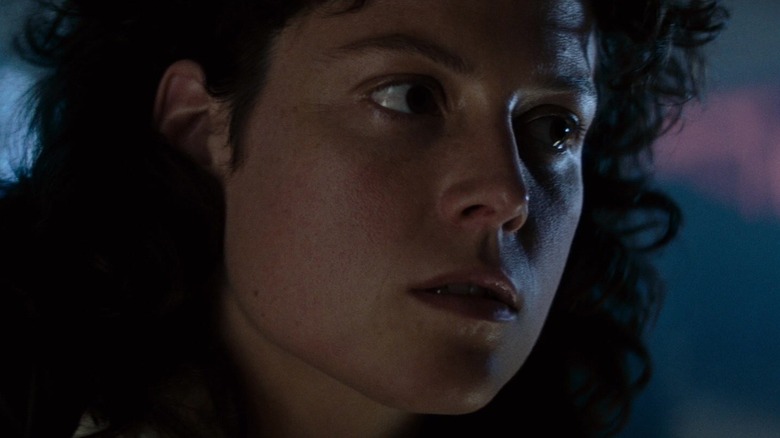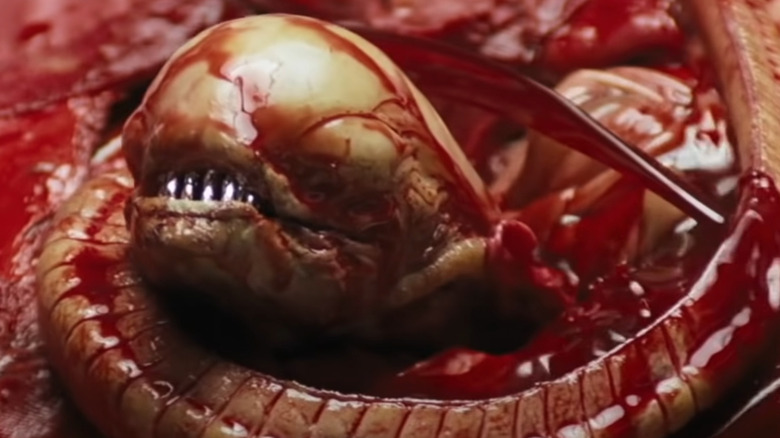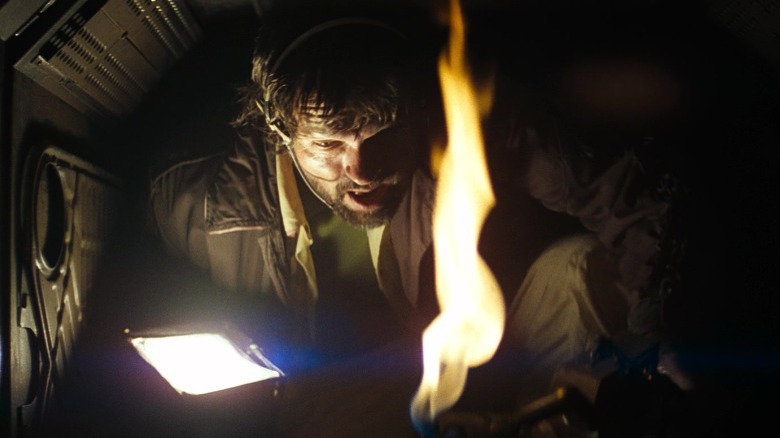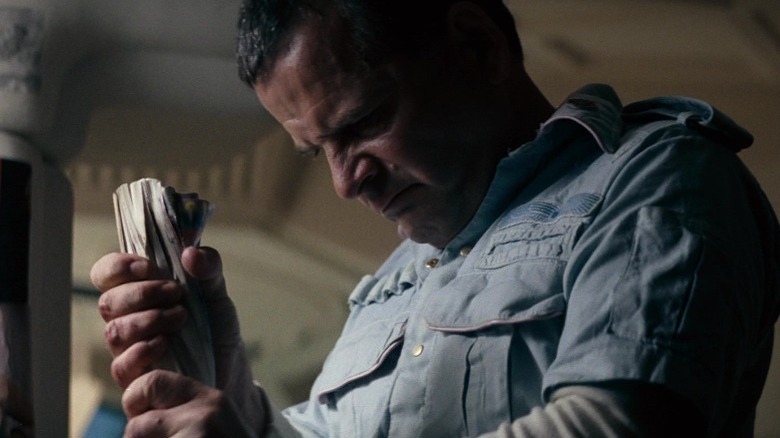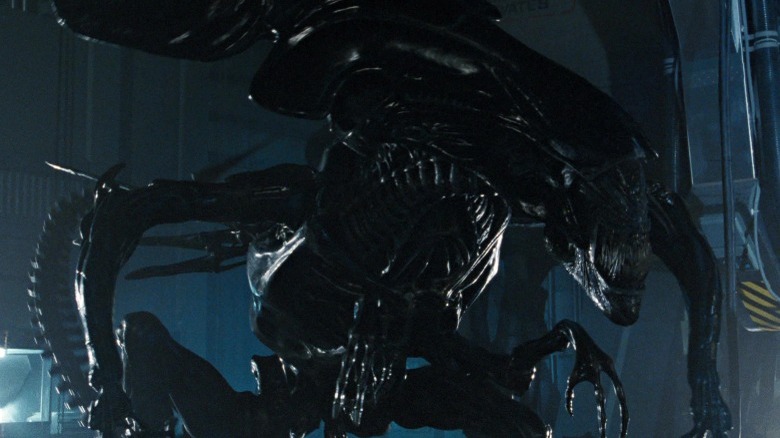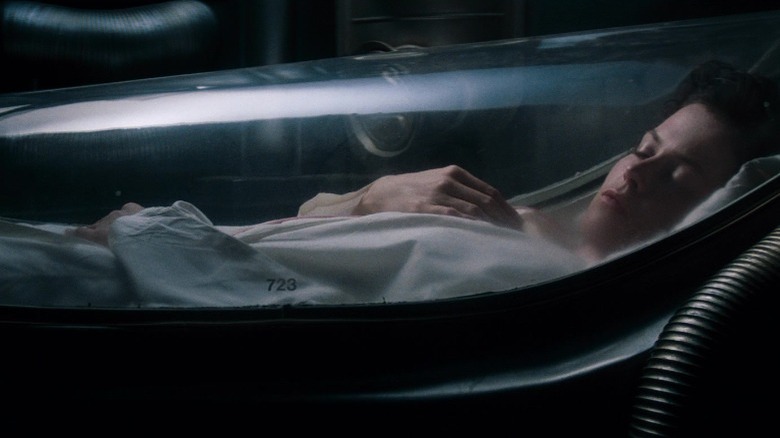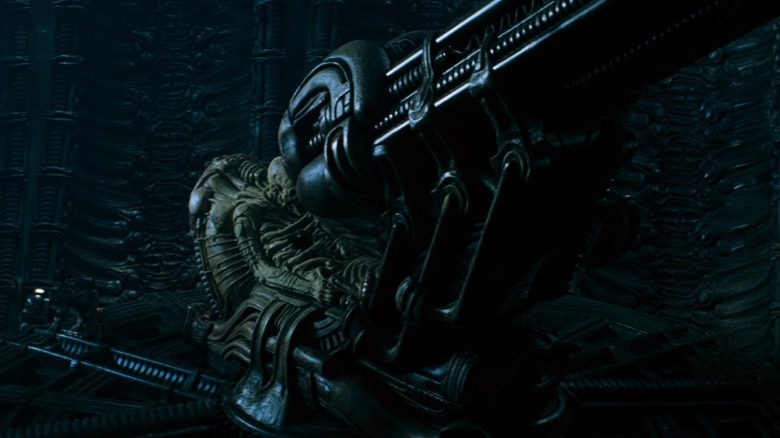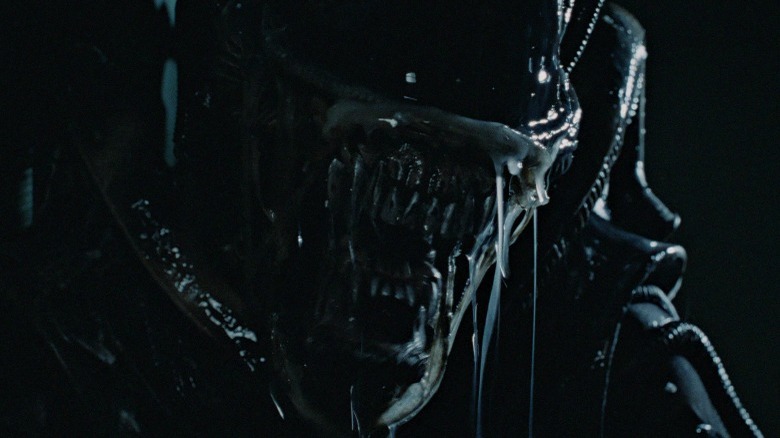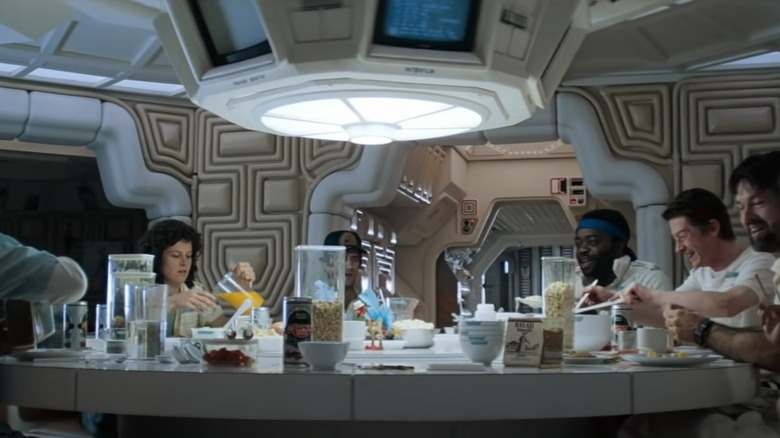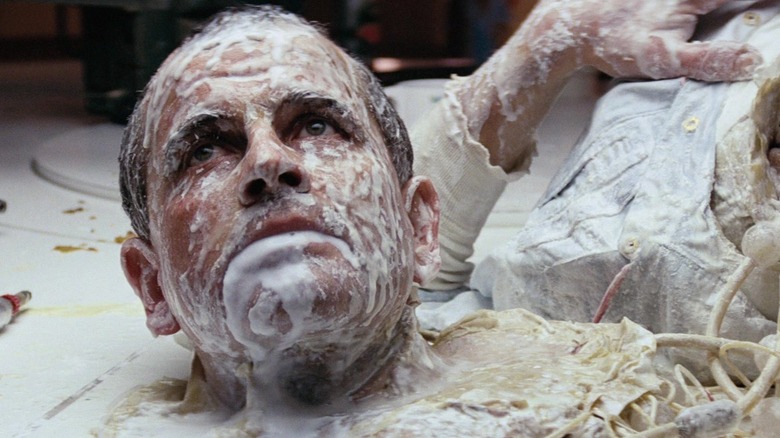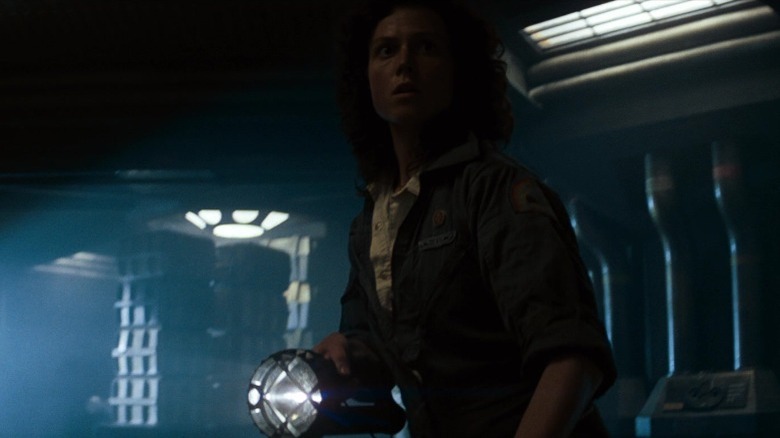The World's Most Difficult Alien Questions Answered
Spoiler alert: In the dinner scene from "Alien," the alien is going to burst out of Kane's chest.
We bet you already knew that. The chestburster scene is widely recognized in pop culture now, and the iconic movie has spawned so many sequels (and has been ripped off so much) that we suspect nobody is surprised anymore. But if you had been in the audience the day "Alien" first came out, it would have been completely unprecedented. We can't even imagine what it would be like to have the rug yanked out from under you in such a gruesome, unsettling way.
Perhaps one reason why "Alien" still gives us the creeps is that its director, Ridley Scott, never tries to explain anything. We don't know where the alien comes from, how it can borrow certain physical attributes from its host, or why nothing seems able to kill it. Arguably, the most disturbing moments in horror movies are the ones that make no sense and happen for no reason. If there's a logical explanation, then it's not nearly as scary. For this reason, there is no point trying to answer any of the numerous burning questions people have about "Alien," lest we spoil its creep factor. So move along, folks. There's nothing to see here.
Still here? Okay, fine. If you insist, we'll go looking for answers to the world's most difficult "Alien" questions. But if that search leads us to a facehugger, don't say we didn't warn you.
Why do we never see the xenomorph fully until the end?
Surprisingly, the alien everybody pays to see barely appears in the movie. But when you finally see the xenomorph in all its disturbing glory, it's totally worth the wait. We think the final reveal wouldn't be half as creepy if the creature had gotten more screen time beforehand. "Alien," according to Vox, relies primarily on terror, the fear that something frightening might happen, instead of the shock of watching something frightening. This is extremely effective because when viewers fill in the blanks in their heads, it's 10 times scarier than anything Scott could possibly capture on film. Just think of Dallas (Tom Skerritt) crawling through the air ducts, arguably one of the scariest scenes in "Alien." We know that the creature could jump out at any second, but since we can't see it coming, we are all the more terrified.
Ridley Scott never gives you a good look at the creature, obscuring it in shadows or smoke or providing only quick flashes of the creature's jaws or tail. Like Scott says in the documentary "The Beast Within: The Making of 'Alien,'" "If you think you've seen something, it's always going to be probably more horrific and horrifying." Scott has a firm conviction that less is more when it comes to horror. "They say you don't see enough of the alien," he said in the 20th-anniversary edition's DVD commentary. "I think you see plenty of the alien."
Why does Dallas die so early in the movie?
For much of the movie, viewers have every reason to believe that Dallas is actually the main character. He's the captain, after all, and he makes many of the key choices in the story. Tom Skerritt even gets top billing. Yet the creature claims Dallas when there are still 40 minutes left to go, which leaves many viewers wondering, now what?
That's precisely the point. "Alien" gladly lets viewers assume Dallas is the hero, knowing it will be all the more shocking when he's one of the first to die. This plot point is perfect for the arc of Ripley (Sigourney Weaver), since it means she must step up as the leader. More importantly, it rattles viewers — if Dallas can die, then anyone can die. Plus, "Alien" gives agency to the characters who weren't usually the heroes of horror movies at the time. The Mary Sue argues that it shouldn't be surprising: "The only people with any sense at all are Parker (Yaphet Kotto), Lambert (Veronica Cartwright) and Ripley," the three characters who felt most strongly that investigating the distress call was a bad idea.
Tom Skerritt is happy to play "second fiddle" to Weaver, he said in an interview with IGN. "It's nice to be in a great orchestra," he said.
Why does Ash try to kill Ripley in such a bizarre way?
In "Alien," the android Ash (Ian Holm) does something that seems to make zero sense. Whenever Ripley tries to warn her crewmates that Ash is trying to get them killed, the android attempts to kill her by shoving a rolled-up magazine down her throat. Rather than, y'know, killing her the normal way — he's certainly strong enough for that — Ash uses a highly unorthodox murder weapon. Why?
Director Ridley Scott meant for the scene to be not just an attempt to kill Ripley, but also a twisted sort of wish-fulfillment for Ash. Scott decided that the android must feel sexual urges, just like his human crew members, and his attack on Ripley is the only outlet for his repressed desire. "Rather than just beating her up," Scott said in the audio commentary for the Alien Quadrilogy DVD (via fan blog Alien Explorations), "isn't it more interesting [if] he actually has always wanted to [have sex], and here's his opportunity but he doesn't have that part ... " For lack of this particular part, Ash uses a rolled-up porn magazine. Given all the other creepy sexual imagery in "Alien," we have to admit that this scene fits right in.
What is the sex of the xenomorph?
This is hardly the first thing you would worry about if a xenomorph was attacking you, but do xenomorphs have sexes the same way humans do? "I think it's a hybrid, I think it could be either," Ridley Scott told Digital Spy, citing examples of real-life insects with hermaphroditic qualities. Scott explains in the Alien Quadrilogy DVD commentary (via fan blog Alien Explorations) that he meant to hint the creature was an "androgynous male/female [...] who could give birth itself, [but] it could also impregnate."
The sequel "Aliens" offers more insight into the biology of the creature. For one, it establishes that the Queen lays the eggs, and it seems like she doesn't need another alien to impregnate her, according to fan blog Strange Shapes. Director James Cameron explained in an interview (via Geek Tyrant) that xenomorphs can change their sex if necessary. The xenomorphs only need one Queen, but they can always use more drones or warriors, so Cameron figured all the other female larvae "biochemically sense that a queen exists and change into males to limit waste."
If that sounds completely out of this world, think again. Some real-life animals can change their sex in response to their environment, says Inverse. In his audio commentary (via Alien Explorations), Scott said he drew inspiration from "a little bit of good old mother nature."
Was there really a deleted scene with an egg stowed away in the shuttle?
If you think "Alien" is pretty bleak, you can at least take consolation in the fact that it could've been even bleaker. Ridley Scott originally had an alternate ending in which Ripley died. Needless to say, 20th Century Fox shot down the idea of having the alien tear Ripley's head off. However, the film almost had an equally tragic ending.
In one draft of the script, Ripley successfully beats the xenomorph, but the camera reveals an alien egg hidden aboard the shuttle. The only source that states this ending was actually filmed is an interview with artist and production designer H.R. Giger for Famous Monsters of Filmland #158 (via fan blog Alien Explorations). Giger, who designed the xenomorphs, recalled, "Oh, yes. There was an egg on board. Once we showed a preview audience a final scene where there was a cocoon in a corner of the shuttle."
However, CBR guesses Giger was probably mistaken about the scene being shown to a preview audience. This is because Scott was given a very short period of time to shoot the final scene (he was already over-budget), so he wouldn't have gotten a chance to film a test shot that the studio probably deemed unnecessary. Perhaps it was for the better. If they kept that deleted scene, we might have never gotten "Aliens."
What happened to the dead Space Jockey?
One question left open at the end of "Alien" is the story behind the spaceship (dubbed "the derelict") carrying the alien eggs and the fossilized "Space Jockey" pilot.
"I figured the Space Jockey was somehow a pilot, and he's part of a military operation [...] and therefore this is probably [...] a weapon carrier," Ridley Scott explained in the Alien Quadrilogy DVD commentary (via Film School Rejects). Meanwhile, in an interview (via Geek Tyrant), "Aliens" director James Cameron speculated that the Space Jockey "became infected en route to somewhere and set down on the barren planetoid to isolate the dangerous creatures." This would likely explain why the Nostromo received the warning signal from LV-426; it was the Space Jockey's attempt to spare others the same fate.
The prequel to "Alien" offers even more answers. In "Prometheus," we learn that the Space Jockey's body is not actually elephant-like, as the skeleton in the original 1979 movie suggests. The pilot is actually from a humanoid race called the Engineers, wearing an elaborate spacesuit. The ending of "Prometheus" shows an Engineer killed when an early prototype of the xenomorph (called "the Deacon") erupts from his chest.
Why does the xenomorph kill some humans and impregnate others?
For fans who aren't familiar with the life cycle of xenomorphs, the creatures may seem strangely inconsistent. They don't always kill everything in sight. For instance, the xenomorphs in "Aliens" killed the pilot Ferro (Colette Hiller) on the spot, yet left Newt (Carrie Henn) and many colonists alive.
"Aliens" director James Cameron has an answer to this question. "Ferro was a greater threat, piloting the heavily armed dropship," than she was a desirable alien host, he explained in an interview (via Geek Tyrant). Meanwhile, Newt wasn't an immediate threat, so the xenomorphs brought her back to the hive to be used as a living host. According to Inverse, "If a particular human reacts violently or doesn't make a suitable host for the growing young, the xenomorph simply kills that human and moves on." This might explain why the alien doesn't immediately kill Ripley in the shuttle at the end of the first movie.
Many viewers assume that the xenomorphs are malicious killing machines that exist purely to make Ripley's life miserable. But Sigourney Weaver has a different idea. "The alien isn't evil," she said in an interview with Films and Filming (via fan blog Strange Shapes). "It's just following its natural instincts to reproduce through whatever living things are around it." Of course, this is only a small consolation for its victims, since becoming an incubator for a chestburster is no picnic, either.
Why do none of the characters in Alien have backstories?
Ridley Scott is known for being blunt and no-nonsense, and this is especially true of his approach to the characters of "Alien."
He told The Hollywood Reporter, "I wasn't too popular with some of the actors because I'd say, 'If it catches you, it's going to take your head off and stick it in a dark place. That's your motivation.'" Scott's goal was to keep things simple and make sure the actors were only focused on what was right in front of them. He added that he would say, "I don't want to know about where [your character] came from, who your mum and dad was, all that crap." No backstories allowed. Perhaps this was because he wanted each crew member to be an Everyman — someone viewers could see themselves in.
Scott went out of his way to make sure that Lambert (Veronica Cartwright) in particular would serve as an audience surrogate. Even though Lambert is often seen freaking out and may not seem as brave as Ripley, she's still more important than you realize. Her panic and paralyzing fear are exactly how most of us would react if we were in her shoes, which makes her an emotional anchor for viewers. Scott probably decided not to get into elaborate backstories because he knew keeping it vague would make his heroes more realistic and more relatable.
Why does Ridley Scott prefer the original theatrical cut to the director's cut?
In 2003, Ridley Scott released a "director's cut" of "Alien," but that's actually a misnomer, says professor and film critic M. Keith Booker: Scott actually likes the theatrical version better.
In the DVD booklet of the Alien Quadrilogy edition (via VHS Collector), Scott explains that 20th Century Fox suggested he add back in some deleted scenes to give audiences new material for the 2003 edition. Scott re-inserted some material but found that the resulting film was way too long and that the flow had been disrupted. "I cut those extra scenes out for a reason," he said. Scott found himself amending certain scenes that had already appeared in the original to make room for the new content. This, he felt, was an "appropriate middle ground," but still nowhere near as good as the original. "For all intents and purposes, I felt that the original cut of ['Alien'] was perfect," he concluded. "I still feel that way."
What makes the theatrical cut superior in his eyes? One key difference is that the director's cut includes a deleted scene in which Ripley finds Dallas still alive, wrapped in a cocoon with an alien egg sprouting from his body. Had this scene been canon, it would have been inconsistent with "Aliens" and James Cameron's idea for the Alien Queen. According to IGN, both Scott and actor Tom Skerritt agreed the scene interrupted the intense pacing of the third act.
Why is everything on the Nostromo so low-tech?
One of the reasons "Alien" is unique is that it depicts a future that isn't remotely futuristic. The Nostromo is filled with grimy industrial pipes and archaic computer monitors. Forget cutting-edge technology — the crew needs to use flamethrowers and a clunky old motion detector. There's not even one measly lightsaber.
This is all very intentional. "Alien" art director Roger Christian told Forbes that Ridley Scott was going for a "dirty, gritty real space-truck look," in stark contrast to "Star Trek" and other sci-fi movies of the era, with their flying cars and friendly robots. Scott wanted a real world populated with real people, so naturally, real-life technology (or at least sci-fi tech that resembled it) was part of the package. Plus, it makes sense that the characters in "Alien" use tech that is so ill-equipped for their mission, because their company, Weyland-Yutani Corp, is notoriously cheap.
You'll notice that in the climax, Ripley takes out the alien with a good old-fashioned harpoon gun rather than a laser gun. Scott explained in the 20th anniversary DVD commentary (via fan blog Alien Explorations) that he fought to keep the harpoon, though others at the studio were dubious that Ripley would choose such a low-tech weapon. Scott pointed out that a harpoon would serve a dual purpose, since Ripley could also use it to anchor herself and avoid getting sucked out into space. More importantly, he said, "A gun is too easy."
